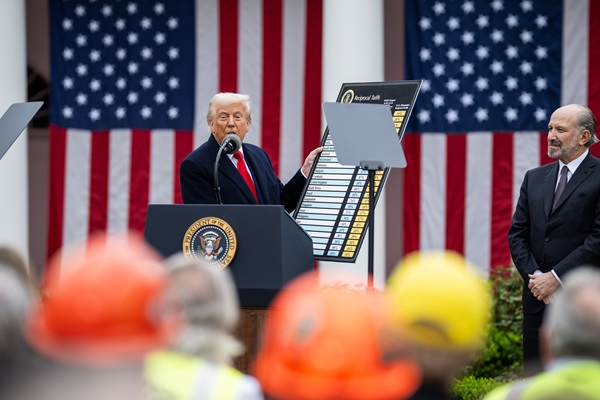.png)

Dhananjay Sinha, CEO and Co-Head of Institutional Equities at Systematix Group, has over 25 years of experience in macroeconomics, strategy, and equity research. A prolific writer, Dhananjay is known for his data-driven views on markets, sectors, and cycles.
April 14, 2025 at 4:47 AM IST
In what may be seen as a climbdown from initial stridency, US President Donald Trump has deferred, for 90 days, the punitive country-specific tariff imposed across nations, reverting to a universal 10% rate. At the same time, he has sharply escalated the tariff on Chinese goods to 145% from 104%, in retaliation to China’s move to raise duties on US goods to 125%. As a result, the average US import tariff has risen to 33%, higher than the initial estimate of 26%.
Markets rallied on this moderation. US indices surged 10–13%, bond yields eased with the 10-year dropping to 4.25% from 4.50%, and the CBOE VIX slid to 35 from 60. Still, volatility remains elevated relative to long-term norms. Risk appetite also returned to global markets, with equity indices in Europe, Asia, and Latin America gaining 3–8%. Indian markets may echo some of this relief.
Yet beyond the initial pop lies a deeper question: is this a genuine retreat or a tactical feint? Given Trump’s erratic policy cadence, the answer depends less on stated intent and more on inferred pressure points.
Strategic Shift
The clearest signals lie in the forces that prompted the reversal. The erosion of $6 trillion in US market cap, widespread domestic protests, and internal fissures within the Trump camp have likely forced a rethink. Another plausible trigger is the suspected selloff of US Treasuries by China, which stoked financial instability by pushing up yields.
More fundamentally, the White House may have realised that triggering a global trade war carries higher risks than the 2018–19 US-China skirmish. Swift retaliation by large economies—China’s 15% tariff on US farm goods, Canada’s planned $155 billion counter-duties, and the EU’s $34 billion response—exposed the vulnerability of $330 billion in US exports. Modelling by the Peterson Institute projected a potential $7.8 trillion GDP loss, far exceeding the estimated $6 trillion in tariff gains.
Domestically, the inflationary impact is just as toxic. The Yale Budget Lab estimates the new tariff regime could cost US households between $2,700 and $3,400 annually. Supply chains are fraying. Stagflation looms.
Widening the lens, Trump’s “reciprocal tariff” doctrine has triggered a multifront economic conflict. A recent MIT study, Disunited Fronts: Military Strategy and Multifront Conflict, shows that spreading resources across multiple adversaries increases the probability of failure. Trump appears to be internalising this lesson, redirecting fire solely at China while easing up elsewhere.
This recalibration also mirrors the growing influence of relatively moderate voices in his team, especially Treasury Secretary Scott Bessent, who views tariffs as leverage rather than blunt force. This approach differs from the hawkish instincts of Commerce Secretary Howard Lutnick and Trade Advisor Peter Navarro.
The revised strategy, though narrower in scope, is far from guaranteed to work.
The idea that China will yield under tariff pressure is belied by history. Trump’s first-term trade war failed to meet its own objectives: US manufacturing jobs fell, exports to China remain underdelivered, and supply chains were simply rerouted through other countries.
China, meanwhile, has diversified. It now has over 190 major trade partners, with the top five’s share down from 63% in 2005 to 37%. Its $463 billion in exports to the US—just 14% of its total—can be redirected, potentially undermining manufacturing elsewhere. Higher tariffs on Chinese goods also create arbitrage via re-exports through third countries.
Beijing also retains tools Trump may underestimate. It could devalue the renminbi to offset tariffs or disrupt US bond markets by offloading Treasuries. These actions, taken together, resemble the slow constriction of a finger trap—an apt metaphor given China’s long game.
Trump’s obsession with a bygone industrial ideal runs counter to China’s bet on the future. With global leadership in AI, green tech, electric vehicles and robotics, China is defining the next growth frontier. Xi Jinping’s rhetoric on equitable globalisation, innovation, and digital cooperation stands in contrast to Trump’s brand of nostalgic protectionism.
Trump’s neo-mercantilism seeks to imitate China’s success post-1970s, but Beijing’s evolving state capitalism remains more agile and better aligned with global trade currents. Even as the US pushes anti-multilateralism, China is positioning itself as a flagbearer of a new global order—especially for the global South.
Trump’s strategy of isolating China may seem like a bold gamble, but it risks backfiring. The more force he applies, the tighter the trap becomes. His punitive tariffs remain nearly three times above pre-Trump 2.0 levels. And by concentrating the pain on China, he could end up giving Beijing an opening to exploit others’ discomfort—and test America’s economic resilience.
With executive orders still in play and campaign rhetoric heating up, the real danger lies ahead. If Trump’s latest bet flounders, his next move may not be recalibration. It could be an escalation.




